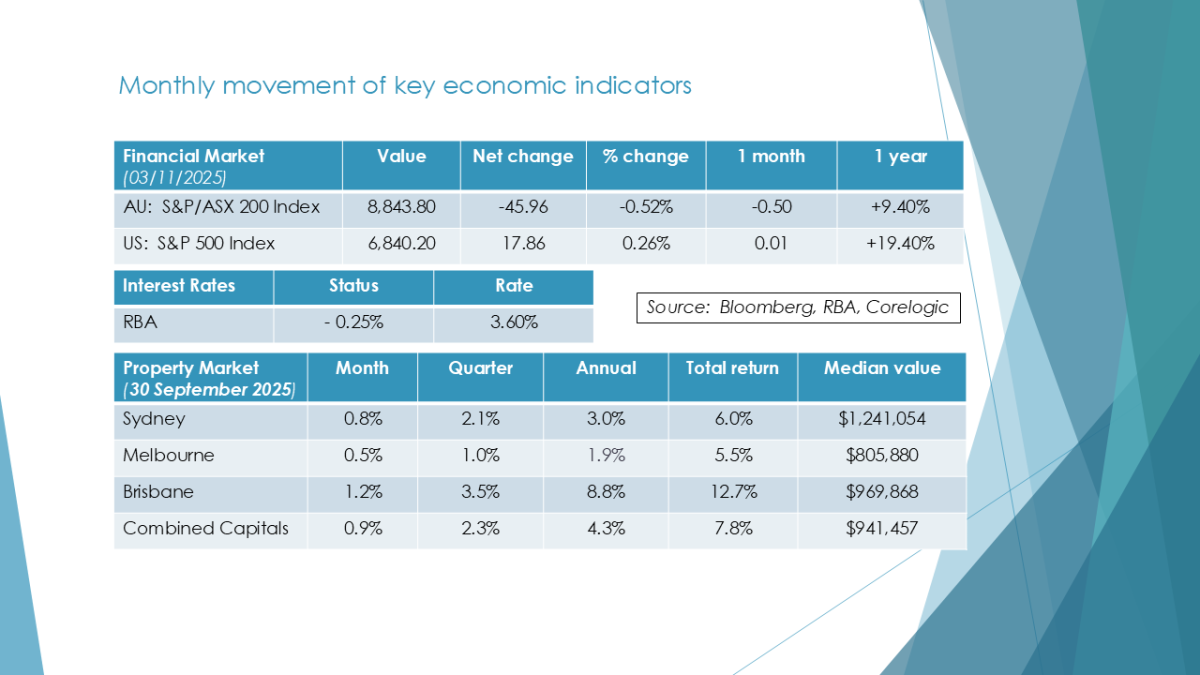Greetings,
Australian Interest Rates
Normalised CPI came in at 1% for the quarter and 3% for the year which is at the higher level of the RBA Inflation band. This was driven primarily by an increase in housing costs and various electricity subsidies now being wound back. This was higher than was expected and now means that it is very unlikely that there will be an interest rate reduction this side of Christmas. As always, we need to be careful with statistics and sometimes there is a correction at a later stage but as it stands the RBA will prioritise keeping inflation within their target range as opposed to assisting mortgage holders with lower interest rates. This does of course impact on confidence including valuations of listed property trusts, which fell after the news came to market. The corollary of this is that saving cash rates should not decline as much as previously expected.
How is Inflation Measured?

Source: RBA
In contrast the US reduced their interest rates overnight but possibly slowing down the trajectory further rate rises for this year. There is a fine balancing act in getting interest rate policy to stimulate an economy while avoiding asset bubbles leading to bigger problems in the future. At the same time, there is immense political pressure to get interest rates down which is good for reducing government interest payments on their debt. This allows money currently being paid in interest to be reallocated to more economic valuable activities such as health and education. As an example, the US is allocating more funds to debt repayments than they are to defense.
U.S. Government Spending Pie Chart for FY 2025
Source: US Government Spending

AGM Season
We are currently in the AGM season for public companies in Australia, I am attending a number of these on behalf of clients. At these meetings, guidance is generally given for the prospects of the company over the next 12 months which then reflects in analyst valuations and then future share prices. While Australian share prices do look fully valued now, we are still seeing significant opportunities in a smaller mid cap markets for innovative companies with the potential to grow significantly over the next couple of years. Generally, these are run by owner/ founder first generation managers who have a clear purpose and the determination to succeed in bringing a significant product to market that adds value to the wider community. Where companies have delivered disappointing news at their AGM, the stock market has been quick to react and in the case of CSL Limited was down 15% on their market update.
The larger listed companies tend to be run by professional managers who are much more risk adverse. They rarely hold a significant number of shares in the company and are very well paid to keep the status quo and maximise their own remuneration arrangements. With our strict continuous disclosure obligations to the ASX we can be confident that the market is fully informed but the corollary of this is that it is less likely that any of our major companies will make any dramatic changes that could significantly improve their share prices. One area of optimism is, however, private equity moving into buying listed companies typically at a 40% premium to their current share price and then removing them from being a listed company.
With around 25% of superannuation funds now in the retirement phase the need for consistent and reliable dividends fully franked from our larger companies really does underpin their share prices and drives much of the decision making. There is also a growth in the share for income managed funds seeking to maximise the income from dividends for retirees, which we are actively supporting.
Plato (PL8) Monthly Dividends

Source: Plato Investment Management
International Shares
Again, still dominated by the application of artificial intelligence (AI) the poster child Nvidia hit new all-time highs and is now valued at $5US trillion. In context this is larger than both the German and the Japanese stock market and twice the size of Australia. They are closely followed by Microsoft and Meta all of which are seeking to build vast data centres globally, to be able to efficiently manage the anticipated future demand for AI. There is of course a risk that all this capital expenditure is not properly directed and that results disappoint leading to a saturation of access to AI and growth slows rapidly. At this stage much of their revenue is coming from companies using this data to proactively target marketing based on the information provided by the end consumer. This has significant ethical challenges if the data is not securely managed. AI should improve all our lives quickly, but it is possible that we reach a stage where this becomes second nature and then less valuable (think streaming TV).
Nvidia (NVDA) stock – 12 month to Nov 2025

Source: Google AI
At a business level, the reality is that AI is replacing human labour and in many occupations such as medical procedures getting a better more consistent outcome for the end consumer. The contentious issue is how the improved productivity is shared between Government, business owners and employees. Several European countries are now actively testing 4-day weeks and working from home options are now deeply embedded in the psyche of the community. All of this can be very positive if it is managed in a transparent and fair manner. It does require all of us to work at a higher level of skill and decision making and accept that more manual work will be automated and that this is a far more efficient use of our time.
Aerial View Of Nvidia’s Endeavor and Voyager Buildings In Santa Clara, CA

Source: Forbes
Australian Property
This has been a very strong quarter for residential property throughout the nation which is significantly improved the assets of many homeowners in our community. The question now becomes how this additional wealth is reinvested (if at all). Indeed, we are watching some of this being directed into gold as seen in Martin Place now. If interest rates are on hold for a significant period, this may dent consumer confidence and while the owner-occupied market would remain strong there would be less incentive for investors to double up with further commitments into the residential property market.
Queuing to buy gold in Martin Place

Source: Australian Financial Review
The ideal scenario is this Goldilocks position of steady growth in the market without excessive overconfidence. Balancing the needs of the wider community and in particular, young people buying their first home supported by the 5% deposit from the federal government guarantee. The supply shortage of properties, particularly in our cities is well known despite government intervention seeking to reduce red tape and until there is an increase in adequate supply you would anticipate properties growing in value at higher than inflation.
The rental market is still very strongly supported by overseas students and the data we see now is that this is far higher than was budgeted at the beginning of the year. Students do stimulate the wider economy but has the potential for abuse where the real goal is to gain permanent residency rather than academic qualifications and requires rigorous government oversight. As of January to August 2025, the total number of overseas students in Australia was approximately 804,555. The number of commencements fluctuated depending on university admission policies.
Quarterly Median House Prices October 2025

Source: Property Update by Metropole
Our News
With approximately 2700 Australians retiring each week the demand for financial advice in the country is at an all-time high. We are prioritising friends and family of existing clients to guide them through this important phase of their lives and ensure that they have the confidence to enjoy their retirement knowing that their finances are being professionally managed in their best interests.
We will be gearing up for our usual Christmas functions soon and very much look forward to seeing you face to face.
Sincerely
Tony and Fiona
Please note this newsletter is of a general nature only. Click to our websiteABN 42 060 673 814 • AFSL No. 407238


